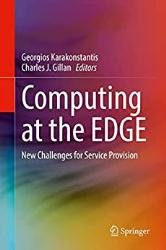 Название: Computing at the EDGE: New Challenges for Service Provision
Название: Computing at the EDGE: New Challenges for Service ProvisionАвтор: Georgios Karakonstantis, Charles J. Gillan
Издательство: Springer
Год: 2022
Страниц: 220
Язык: английский
Формат: pdf (true), epub
Размер: 33.9 MB
This book describes solutions to the problems of energy efficiency, resiliency and cyber security in the domain of Edge Computing and reports on early deployments of the technology in commercial settings. This book takes a business focused view, relating the technological outcomes to new business opportunities made possible by the edge paradigm. Drawing on the experience of end user deploying prototype edge technology, the authors discuss applications in financial management, wireless management, and social networks. Coverage includes a chapter on the analysis of total cost of ownership, thereby enabling readers to calculate the efficiency gain for use of the technology in their business.
Given the relative geographical remoteness of the traditional cloud data centre in the IoT environment, the seemingly obvious first step is to try to move the computing closer to the data source in order to overcome issues of latency. This is known as edge computing, meaning that significant amounts of processing, but not necessarily all of it, take place close to where the data is collected. Edge computing is in essence a model or a concept. There are potentially many ways to implement this concept in practice. Fog computing is an architectural model for the implementation of edge computing with its roots in the work of Bar-Magen et al.
All of the architectures for computing at the edge are dependent on improving the performance of servers that run Internet/cloud-based services, while reducing their design and implementation cost as well as power consumption. This is very important for reducing the running costs in a server farm that supports data centres and cloud providers, while at the same time it enables the placement of servers co-located with the origin of the data (e.g., sensors, cameras) where electrical power is generally limited. In addition, all these new efficient servers need to be able to support useful attributes of software stacks in common use by cloud service providers that facilitate migration and programmability. What is more, there is a need to re-think continually the architecture model of Internet in terms of sustainability and security. This book presents some of the latest work in these fields.
There are various surveys about Edge/Fog computing in the literature. What is missing though in the above surveys is the description of the software-engineering aspects of the applications that are built/deployed via the edge. These aspects would be then useful for abstracting the software-engineering process that is/should be followed by practitioners to build their edge-enabled software applications. To cover the above objectives, we first specify the core concepts of the general-purpose software-engineering process, the multi-tier architecture of edge infrastructure, and how software applications are deployed to such an infrastructure. Following, we describe the related surveys for edge computing and how the current chapter goes beyond those surveys. We then describe the software-engineering aspects of edge-computing approaches. Finally, we outline the view and the role of a software-engineering process for Edge Computing, along with research challenges in this process.
Скачать Computing at the EDGE: New Challenges for Service Provision